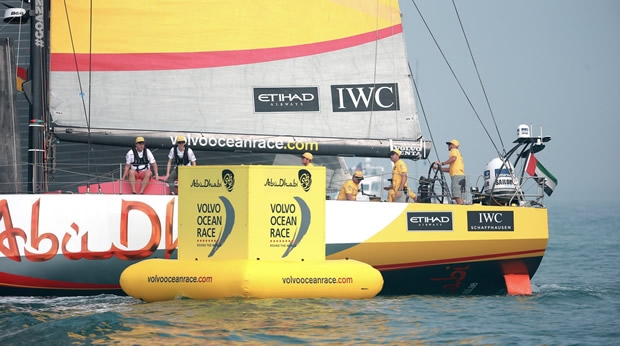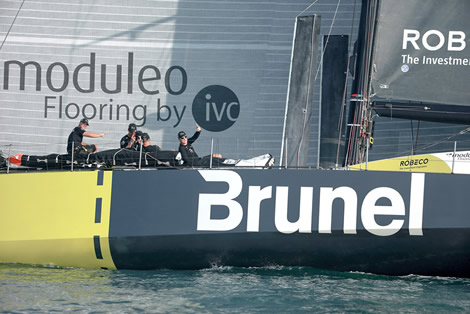Abu Dhabi Ocean Racing leads out of her homeport
Abu Dhabi Ocean Racing led the Volvo Ocean Race fleet out of his homeport on the 4,670 mile Leg 3 to Sanya, China, the start taking place at 1300 UTC.
Proceedings were hampered by a blanket of fog, that enveloped the course from early morning and stubbornly refused to shift, even under the normal hot midday sun. Instead the teams had their work cut out even to see the turning marks through the murk before leaving the port where they had enjoyed such a wonderful break.
After two laps of an inshore course close to the Abu Dhabi waterfront, the fleet of six Volvo Ocean 65s headed down the coast of the UAE towards the Strait of Hormuz, the first of many landmarks, before the boats head out into the Gulf of Oman, ccross the Indian Ocean, round the tip of Sri Lanka, head east for Malacca Strait, which separates the Indonesian island of Sumatra and Malaysia, which in places narrows to just 1.5nm and is one of the busiest shipping lanes in the world.
“It’s the most challenging part of the whole race,” Team Alvimedica navigator Will Oxley said. “I'm pretty happy dealing with big waves and strong winds, but the complexity of dealing with a narrow channel, and a very large amount of shipping is what causes the problems. Some 300ft of steel coming at you at 20 knots is always concerning, particularly if you haven't got much control over your speed if there's not much wind. Then you have squalls, very violent squalls in the night, and there's lots of fishermen who are not showing navigation lights and have long nets. You can get tangled in the nets, or worse still, run someone over. So it's very stressful.
“Instead of sailing in some of the most isolated places in the world, we're sailing in some of the most populated places in the world. So the dangers become human as opposed to the elements,” Oxley concluded.
With that said, the first week and a half should be a little more sedate, with a light passage predicted through the Indian Ocean. “It's going to be quite light getting out of the Gulf of Oman, and then we're transiting around a high pressure system, working our way east, close to Pakistan, then coming down around India, where it could be very light, and then a lot of wind where it funnels between India and Sri Lanka.”
At the southerly end of Malacca Strait, the botas pass Singapore, then sail up the South China Sea, along the Vietnamese coast and finally into Sanya – an island off China’s south coast. Light winds are forecast for the first few days of the leg which is expected to take about three weeks before the six boats arrive in Sanya, the seaside resort on the island of Hainan in the south of China. The best estimates are for the boats completing leg 3 in 23 to 24 days.
Abu Dhabi Ocean Racing skipper Ian Walker and navigator Simon Fisher read the shifting breeze to perfection on the first lap, timing their tack to make the best of a windshift that propelled ADOR’s yacht Azzam into a commanding lead at the first turning mark. Walker’s crew consolidated its advantage around the rest of the inshore course to lead the fleet at the final turning mark after just under an hour (59min 34secs) as the sun finally began to poke through followed by Dongfeng Race Team and Team SCA.
At the end of the two inshore laps, it was time for the ‘Jump Seat’ passengers on each of the six boats to leap overboard and get a ride back ashore.
ADOR skipper Ian Walker looked forward to the leg to Sanya: “The performance gap is narrowing between the teams as the race progresses and I wouldn’t be surprised to see one or more new faces battling for the lead on the way to China."
Team Alvimedica's skipper Charlie Enright sees 24 days of uncertainty ahead for his young crew on the Turkish-American VO65: “It’s tough to look more than 24 hours ahead because the changes are happening as we speak. Hopefully the fog will burn off and a sea breeze will arrive. We should have decent conditions at the Straits of Hormuz. I think we can expect a good first 18 hours of sailing and then a great deal of uncertainty after that. It's good to get back on the water now. We're looking to capitalize on a few things. We've improved on our boatspeed and other processes on board, and I think we can see some improvement in our overall leg finish too.”
Team Brunel navigator Andrew Cape looked forward to leg 3: “This will be one of the toughest legs of this race. The start is difficult. If we are lucky and there is wind, within 24 hours we will sail through the Strait of Oman in to the Arabian Sea. But if the wind is light, it can take much longer. Maybe two days. Once on the Indian Ocean we'll be encountering narrow waterways, small islands, pirates, debris, floating containers and enormous ocean-going vessels, but also fishing nets and many fishing boats with neither lighting or communication equipment.
"An important problem is that this section of the Indian Ocean has never been properly charted. Another area of attention is that the seabed is unstable here. The depth shown on the maps need not necessarily make sense, therefore. In order to avoid sailing into any of these obstacles, we use our radar a great deal, along with the Automatic Identification System (AIS) and of course the watchful eyes of the crew."
“It will also be an unpredictable leg," adds Team Brunel skipper Bouwe Bekking. “Anything can happen, especially when it comes to the weather, which is even more difficult to predict during this leg than during the past stage. I'm expecting very high temperatures and plenty of rain. We don't always have tailwinds either. Some sections will even be very close to the wind. The last bit just before Sanya will be rough. We'll be fighting the strong prevailing winds from the north-east. I believe anyone can win. The cards have been completely reshuffled, it is a one-design class after all."












Latest Comments
Add a comment - Members log in